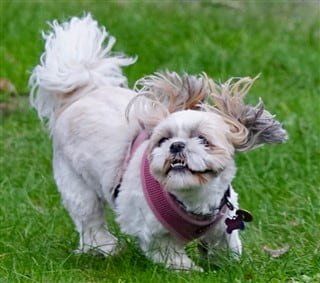Exercise and Activity Requirements for the Shih Tzu
Overview
Please note: AllShihTzu is reader-supported, and some of the product suggestions on this page are affiliate links. As an Amazon Associate we earn from qualifying purchases. This is at no extra cost to you and helps keep this site running.
The Benefits of Exercise for a Shih Tzu
- Strengthens a dog's heart and improves blood circulation (for fewer heart-related issues down the line)
- Helps the body manage glucose levels (reducing the chances of developing canine diabetes later in life)
- Is thought to play a role in keeping the immune system strong and even extending life span.
- Strengthens a dog's bones and supporting muscles (for fewer hip and knee issues)
- Helps keep the metabolism functioning properly
- Helps stimulate the appetite
- Aids in a good night's sleep
- Allows a dog to engage their canine senses (hearing, scenting, sight), which often leads to a more emotionally satisfied dog
- Helps a dog release pent-up energy that may otherwise be directed toward behaviors like excessive barking or chewing
- Outdoor exercise can enable a Shih Tzu to be exposed to stimuli, which eventually leads to less reaction (i.e. barking at other dogs)
Defining Healthy Exercise for a Shih Tzu
When it comes to a Shih Tzu, exercise should be gentle, consistent, and never overdone. As a brachycephalic (short-nosed) breed, Shih Tzus are prone to breathing difficulties, so the goal is not heavy panting or exhaustion. Instead, healthy exercise means moderate cardiovascular activity that gets the joints moving, keeps muscles toned, and supports overall health without pushing your dog too hard.
A proper exercise session should:
- Involve steady, continuous movement (not too many sporadic bursts)
- Be long enough to provide physical and mental stimulation, without overheating
- Keep your Shih Tzu alert and engaged, but able to breathe easily throughout
A brisk walk at your dog’s own pace is ideal. It’s structured, easy to time, and provides both physical movement and mental enrichment. Low-impact indoor or outdoor play can help round things out, but true exercise should follow the rule: consistent, moderate motion with controlled breathing.
How Much Exercise a Shih Tzu Needs
When You Can Start Exercising a Shih Tzu
Walking Tips
5. If you're looking to make walks more fun for your Shih Tzu, adding small changes can keep things interesting. Let them take sniff breaks. Vary your route when possible, even just reversing your usual loop or exploring a different sidewalk. Weaving gently around trees or posts adds a playful agility element, and bringing a favorite snack for a quick picnic can turn the outing into a mini adventure. You can also practice simple commands along the way to keep their mind sharp.
Wintertime Exercise Tips
4. Switch over to indoor activities when winter weather is too severe. When temps are below freezing, during snowstorms, or with other inclement weather conditions, it's time to switch over to some indoor activity. Keep reading for some summer tips, or jump down to: Indoor Exercise Tips.

Summertime Exercise Tips
6. If it's just too hot to walk safely, keep your Shih Tzu moving inside. Keep reading for tips on playing fetch, or jump down to: Indoor Exercise Tips.

Tips for Playing Fetch
Indoor Exercise Tips
2. Consider setting up a fun obstacle course with pillows, books or other everyday household items.
3. You can explore walking options outside the house, such as taking some loops around a pet-friendly mall or exploring a store that welcomes dogs.
4. If your Shih Tzu likes other dogs, they may love to burn off some energy by spending an hour or so at an indoor doggie daycare.
5. Help replace the outdoor experience. When a dog can’t get outside the way they’re used to, they may grow restless even if they’re getting some indoor play. That’s because outdoor walks and yard time provide far more than just movement; they offer sights, sounds, and especially scents that keep a dog’s brain active and fulfilled.
You can help make up for this missing enrichment in a few simple but meaningful ways:
- Window Watching: Many dogs enjoy sitting near a window to quietly observe the neighborhood. This can be mentally satisfying and help pass the time as long as a Shih Tzu isn't getting overstimulated or being too reactive, like barking at every passerby. A comfy perch and a low window are often all it takes.
- Sniffing Stations:
Dogs need sniffing like we need reading; it exercises their brain. A snuffle mat (a fabric mat designed to hide treats) can give your Shih Tzu a healthy way to sniff and forage. One that we love is the colorful
Snuffle Mat by Oli. You can also hide small treats in rolled-up towels or safe cardboard boxes.
- Interactive Toys: Puzzle feeders, treat-dispensing toys like the wobbly Bob-a-Lot toy, or frozen lick mats can help replace some of the problem-solving your dog might naturally do during outdoor exploration.
By providing substitutes for both physical and sensory stimulation, you’ll help your Shih Tzu stay content, even when going outside isn’t an option.
A Final Thought
Daily exercise is one of the most valuable things you can give your Shih Tzu. It supports their health in a number of ways, sharpens the mind, keeps the spirit balanced and can even extend their years.
Because this is a brachycephalic breed, exercise should be steady but moderate and focused more on consistency than intensity. With the right routine of paced walks, seasonal adjustments, and gentle play, you’ll be supporting your Shih Tzu’s long-term comfort, mobility, and quality of life.
Take a quick moment to become a free AllShihTzu member. You'll receive a Welcome Booklet and our newsletters to let you know when new articles are added to this site. It's the best way for us to stay in touch, so we hope you'll join us today.
Lists to Love: Treat Edition
Treats for Shih Tzus with Sensitive Stomachs - If your Shih Tzu has a tummy that’s quick to protest, finding the right treat can feel like a guessing game. Thankfully, there are gentle options that dogs find super-delicious. See our list of the best belly-friendly treats.
Healthy Yummy Cheese Treats for a Shih Tzu - Is your Shih Tzu a true cheese connoisseur or a doggo that wants to be, but struggles with dairy? See these tummy-friendly options, including one long-lasting lactose-free chew that’s safe to savor and loved by even the pickiest pups.
Top Fish Treats for Shih Tzus - Don't let your Shih Tzu miss out on the powerful benefits of omega-3s. These wholesome fish snacks support healthy skin, a glossy coat, and smooth digestion, making them a smart & tasty boost to a Shih Tzu’s diet.
Shih Tzu Physical Comfort - How to address the top 5 concerns of: Sensitive skin, tummy troubles, cold intolerance, breathing discomfort and mobility issues in Shih Tzu dogs. Help your Shih Tzu start feeling better today.



